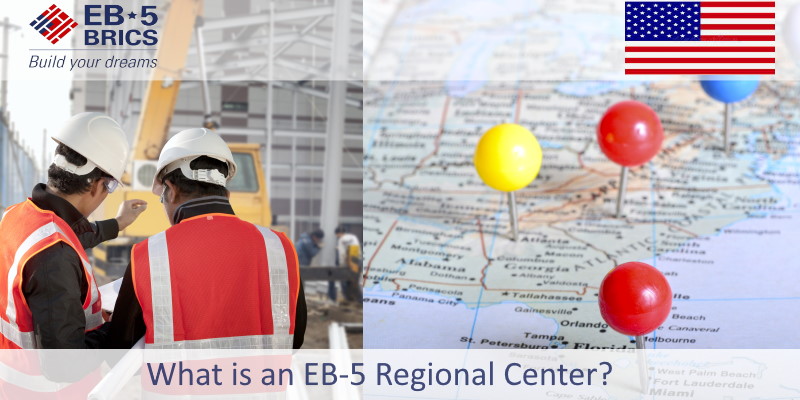The EB-5 Regional Center is a business or public economic entity that stimulates the U.S. economy through foreign investments and job creation. Regional centers are designated by the United States Citizenship and Immigration Services (USCIS). They were created by the U.S. Congress in 1992 to boost the U.S. economy through foreign investments.
The EB-5 investor visa allows overseas investors, their spouses and children under 21 years of age, to acquire permanent resident status through investment. To qualify, the investor must commit a minimum amount of $800,000 to establish a new commercial enterprise. In addition, this new business must be located in a targeted employment area (TEA) and employ ten qualified American citizens in full-time positions.
An EB-5 regional center is a regional center (R.C.) that promotes economic growth. In other words, it is an organization dedicated to achieving the objectives of the EB-5 program, which include stimulating the U.S. economy through foreign investment and job creation. As a result, it is eligible to accept funds from immigrant investors. The USCIS designates these regional centers as intermediaries between investors and EB-5 projects.


The EB-5 Regional Center program was established by the U.S. Congress in 1992. Initially known as the Immigrant Investor Pilot Program, it was created in 1990. The program’s authorization has been extended through 2015, and since then, it has been repeatedly reauthorized for varying durations. If you want to learn more about the i-924 petition, you can find additional information on it.
All EB-5 regional centers and projects must adhere to U.S. securities laws. These laws are in place to safeguard the interests of investors from unethical or incompetent securities sales practices. As defined by the United States Securities Act of 1933, securities encompass stocks, notes, bonds, direct participation program investments, and investment contracts. The U.S. Securities and Exchange Commission (SEC) regulates securities and requires registration with the SEC. In addition, four EB-5 Regional Centers’ security compliance measures are in place.
The EB-5 Regional Center program was established by the U.S. Congress in 1992. It was originally known as the Immigrant Investor Pilot Program, created by Congress in 1990. The program’s authorization was extended through 2015, and since then, the Regional Center Program has been repeatedly reauthorized for varying durations. If you want to learn more about the i-924 petition, you can find additional information on it.
All EB-5 regional centers and projects must comply with U.S. securities laws. These laws aim to protect investors’ interests from unethical or incompetent securities sales practices. As defined by the United States Securities Act of 1933, securities encompass stocks, notes, bonds, direct participation program investments, and investment contracts. The U.S. Securities and Exchange Commission (SEC) regulates securities and requires registration with the SEC. There are four EB-5 Regional Centers’ security compliance measures in place.
The EB-5 Program has significantly contributed to the U.S. economy, amounting to several billions of dollars per fiscal year. Between FY2014 and FY2015, EB-5 Regional Center projects generated $11.2 billion in capital investment. This represents 2% of the total net foreign direct investment (FDI) inflow to the United States during that period. The program’s capital investment and related spending contributed $33.6 billion to the U.S. economy in FY2014 and FY2015. Additionally, tax revenues earned by the program for the federal, state, and local governments totaled $4.2 billion between FY2014 and FY2015. Of this amount, the program’s contribution of $2.7 billion in federal tax revenue is equivalent to 634 percent of the total appropriations made by the federal government for economic development programs through the U.S. Economic Development Administration (EDA) between FY2014 and FY2015, at no cost to U.S. taxpayers.
The EB-5 regional center program reauthorization refers to its renewal after its expiration on June 30, 2021, under the 2022 EB5 Reform and Integrity Act.
Here’s how the EB-5 regional center reauthorization works:
U.S. investors can file Form I-829 (EB5 Application) and I-485 (Adjustment of Status petitions) even if the I-829 form has not been approved yet.
The EB-5 regional center program renewal refers to the EB-5 Reform and Integrity Act of 2022. This bill introduces modifications to several crucial aspects of the Regional Center Program, including a five-year reauthorization period, a regulatory definition for targeted employment areas, and adjustments in the investment threshold amounts, essential investor protections, and additional security and integrity measures.
The USCIS website offers up-to-date information on the approval and rejection rates for I-526 and I-829 petitions. Generally, the acceptance rate for I-526 petitions ranges from about 75% to 80%. Therefore, it can be assumed that applicants who obtain approval for the I-526 form will seek permanent residency status with conditions. Overall, the approval rate for I-829 petitions exceeds 90%.
The EB-5 program offers two investment options for investors: the EB-5 Regional Center and EB-5 Direct Investments. While these two investments may appear similar, there are differences that every investor should be aware of before making a final decision. Here are the three main differences between an EB-5 Regional Center and EB-5 Direct Investment:
Yes, a regional center-affiliated immigration lawyer (attorney) provides support to the regional center in producing the project documentation. These visa attorneys are necessary for regional centers because EB-5 tasks involve highly specialized immigration law. Therefore, not all immigration attorneys can handle EB-5 tasks effectively.
As of July 4, 2021, the USCIS has a list of 673 regional centers. You can obtain a complete list of Regional Centers from USCIS. Here are a few USCIS-approved and operating EB-5 Regional Centers in the following U.S. states:
The main advantage of investing in a Regional Center is related to job creation. When investing in a Regional Center, the USCIS allows the Regional Center to count direct, indirect, and induced jobs associated with the project. In contrast, only direct jobs are counted when investing in a New Commercial Enterprise (NCE). By investing in a Regional Center, the investor is not involved in the day-to-day operations of the new commercial enterprise. Typically, the investor becomes a limited partner in the Limited Liability Company (LLC) formed by the Regional Center, while the Regional Center acts as the general partner. This setup is beneficial for individuals who are solely interested in obtaining an EB-5 green card for themselves and their families and do not wish to engage in any business activities during the investment period. Additionally, investing in a Regional Center grants the investor the freedom to live, work, or travel anywhere in the U.S. without being tied to the specific business they invested in.

The Regional Center’s Focus on Geographical Region and Economic Growth
The Regional Center should provide detailed plans for focusing on a specific geographical region within the United States and promoting economic growth in that region.
Job Creation Strategies and Capital Investments
The Regional Center should outline, with verifiable detail and using economic models where applicable, how jobs will be created directly or indirectly through capital investments aligned with the Regional Center’s business plan. This should include information on the amount and source of capital committed to the Regional Center and the promotional efforts made and planned for the business project.
Positive Impact on Regional or National Economy
The Regional Center should explain how it will positively impact the regional or national economy. This can be achieved through:
An investment through the Regional Center program alleviates the burdensome job creation requirement. The Regional Center program eliminates the need for ten direct employees, as required by the Traditional EB-5 Program, and instead allows for a more flexible “indirect employment creation” approach. The investor must prove that the proposed project will create ten new jobs within the Regional Center’s economy to satisfy the requirement.
The role of the investor in the Regional Center program fulfills the management requirement imposed by federal regulations while allowing them to make an EB-5 investment. As a limited partner, the investor has limited involvement in policy-making but no authority in business operations or day-to-day management. This makes Regional Center programs an attractive option for the majority of immigrant investors who are not interested in the active management of a business. Additionally, this business structure offers investor protection, as their liability is limited to the extent of the EB-5 investment amount.

Numerous approved Regional Centers are listed on the USCIS website, where you can check their status.
EB5 States is here to assist you in navigating the path to citizenship through investment. We have successfully guided many families through the EB5 immigration process. We are ready to answer your questions about direct investment options for EB5 and EB-5 Processing Times and provide a step-by-step walkthrough of the EB-5 program.
Schedule an appointment for a one-on-one session with Vivek Tandon Esq., a U.S. Lawyer and Investment Banker. Contact us for more information.
US Programs
European programs
Email : info@EB5States.com
Copyright © 2022 EB5 States | All Rights Reserved